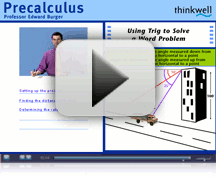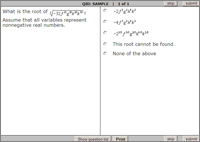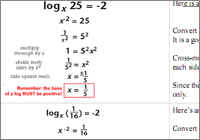Trigonometry
Thinkwell's Trigonometry has high-quality online video lessons and automatic grading that teach you the trigonometry formulas you'll need to succeed in calculus. Thinkwell's Trigonometry covers the same topics that the most popular textbooks cover, so it's a perfect study aid. Instead of trying to learn what you need from an old-fashioned textbook, you can watch easy-to-understand trigonometry videos by one of our nation's best math teachers.
Thinkwell's award-winning math teacher, Edward Burger, can explain and demonstrate trig clearly to anyone, so trigonometry basics are easy to understand and remember. Professor Burger shares the tricks and tips so your students will remember them when they begin calculus. And because it's available 24/7 for one fixed price, instead of by the hour, it's better than a tutor.
Our complete Trigonometry package includes:- 12-month Online Subscription to our complete Trigonometry course with video lessons, automatically graded trigonometry problems, and much more.
- Workbook (optional) with lecture notes, sample problems, and exercises so that you can study even when away from the computer.
Workbooks require the purchase of an online subscription.
Money-Back Guarantee
Trigonometry Materials
Online Subscription, 12-month access
Access to a complete online package that includes everything you need:
- High quality video lessons explain all of the Trigonometry math topics and concepts
- Automatically graded trigonometry problems with immediate feedback allow you to track your progress
- Printable full-color illustrated notes help you review what you've learned in the video lesson
- Subscriptions start when you are ready. Buy now and activate your course anytime you like. Wait up to one year to activate your subscription; your 12-month subscription doesn't begin until you say so!
Workbook, Notes, sample problems, exercises, and practice problems
Study without a computer. Our workbook companion contains the same lecture notes and sample problems that are delivered online, as well as some additional exercises, all in a convenient print format. Answers to the odd-numbered exercises are in the back of the book. Online Subscription is required; workbook not sold separately.
Trigonometry Details
Thinkwell's Trigonometry has all the features your home school needs:
- Equivalent to 11th- or 12th-grade trigonometry
- More than 180 video lessons (see sample)
- 1000+ interactive trigonometry problems with immediate feedback allow you to track your progress (see sample)
- Trigonometry practice tests and final tests for all 8 chapters, as well as a midterm and a final (only available in the homeschool version)
- Printable illustrated notes for each topic
- Real-world application examples in both lectures and exercises
- Closed captioning for all videos
- Glossary of more than 200 mathematical terms
- Engaging content to help students advance their mathematical knowledge:
- Review of graphs and functions
- Trigonometric functions: sine, cosine, tangent, cotangent, secant, and cosecant
- Inverse trigonometric functions
- Trigonometric identities
- Law of Sines and Law of Cosines
- Vectors and unit vectors
- Complex numbers and polar coordinates
- Exponential and logarithmic functions
- Conic sections: parabolas, ellipses, and hyperbolas
Table of Contents
(Expand All - Close All)1. Algebraic Prerequisites
- 1.1 Graphing Basics
- 1.1.1 Using the Cartesian System
- 1.1.2 Thinking Visually
- 1.2 Relationships between Two Points
- 1.2.1 Finding the Distance between Two Points
- 1.2.2 Finding the Second Endpoint of a Segment
- 1.3 Relationships among Three Points
- 1.3.1 Collinearity and Distance
- 1.3.2 Triangles
- 1.4 Circles
- 1.4.1 Finding the Center-Radius Form of the Equation of a Circle
- 1.4.2 Decoding the Circle Formula
- 1.4.3 Finding the Center and Radius of a Circle
- 1.4.4 Solving Word Problems Involving Circles
- 1.5 Graphing Equations
- 1.5.1 Graphing Equations by Locating Points
- 1.5.2 Finding the x- and y-Intercepts of an Equation
- 1.6 Function Basics
- 1.6.1 Functions and the Vertical Line Test
- 1.6.2 Identifying Functions
- 1.6.3 Function Notation and Finding Function Values
- 1.7 Working with Functions
- 1.7.1 Determining Intervals Over Which a Function Is Increasing
- 1.7.2 Evaluating Piecewise-Defined Functions for Given Values
- 1.7.3 Solving Word Problems Involving Functions
- 1.8 Function Domain and Range
- 1.8.1 Finding the Domain and Range of a Function
- 1.8.2 Domain and Range: One Explicit Example
- 1.8.3 Satisfying the Domain of a Function
- 1.9 Linear Functions: Slope
- 1.9.1 An Introduction to Slope
- 1.9.2 Finding the Slope of a Line Given Two Points
- 1.9.3 Interpreting Slope from a Graph
- 1.9.4 Graphing a Line Using Point and Slope
- 1.10 Equations of a Line
- 1.10.1 Writing an Equation in Slope-Intercept Form
- 1.10.2 Writing an Equation Given Two Points
- 1.10.3 Writing an Equation in Point-Slope Form
- 1.10.4 Matching a Slope-Intercept Equation with Its Graph
- 1.10.5 Slope for Parallel and Perpendicular Lines
- 1.11 Graphing Functions
- 1.11.1 Graphing Some Important Functions
- 1.11.2 Graphing Piecewise-Defined Functions
- 1.11.3 Matching Equations with Their Graphs
- 1.12 Manipulating Graphs: Shifts and Stretches
- 1.12.1 Shifting Curves along Axes
- 1.12.2 Shifting or Translating Curves along Axes
- 1.12.3 Stretching a Graph
- 1.12.4 Graphing Quadratics Using Patterns
- 1.13 Manipulating Graphs: Symmetry and Reflections
- 1.13.1 Determining Symmetry
- 1.13.2 Reflections
- 1.13.3 Reflecting Specific Functions
- 1.14 Quadratic Functions: Basics
- 1.14.1 Deconstructing the Graph of a Quadratic Function
- 1.14.2 Nice-Looking Parabolas
- 1.14.3 Using Discriminants to Graph Parabolas
- 1.14.4 Maximum Height in the Real World
- 1.15 Quadratic Functions: The Vertex
- 1.15.1 Finding the Vertex by Completing the Square
- 1.15.2 Using the Vertex to Write the Quadratic Equation
- 1.15.3 Finding the Maximum or Minimum of a Quadratic
- 1.15.4 Graphing Parabolas
- 1.16 Composite Functions
- 1.16.1 Using Operations on Functions
- 1.16.2 Composite Functions
- 1.16.3 Components of Composite Functions
- 1.16.4 Finding Functions That Form a Given Composite
- 1.16.5 Finding the Difference Quotient of a Function
- 1.16.6 Calculating the Average Rate of Change
- 1.17 Rational Functions
- 1.17.1 Understanding Rational Functions
- 1.17.2 Basic Rational Functions
- 1.18 Graphing Rational Functions
- 1.18.1 Vertical Asymptotes
- 1.18.2 Horizontal Asymptotes
- 1.18.3 Graphing Rational Functions
- 1.18.4 Graphing Rational Functions: More Examples
- 1.18.5 Oblique Asymptotes
- 1.18.6 Oblique Asymptotes: Another Example
- 1.19 Function Inverses
- 1.19.1 Understanding Inverse Functions
- 1.19.2 The Horizontal Line Test
- 1.19.3 Are Two Functions Inverses of Each Other?
- 1.19.4 Graphing the Inverse
- 1.20 Finding Function Inverses
- 1.20.1 Finding the Inverse of a Function
- 1.20.2 Finding the Inverse of a Function with Higher Powers
2. The Trigonometric Functions
- 2.1 Angles and Radian Measure
- 2.1.1 Finding the Quadrant in Which an Angle Lies
- 2.1.2 Finding Coterminal Angles
- 2.1.3 Finding the Complement and Supplement of an Angle
- 2.1.4 Converting between Degrees and Radians
- 2.1.5 Using the Arc Length Formula
- 2.2 Right Angle Trigonometry
- 2.2.1 An Introduction to the Trigonometric Functions
- 2.2.2 Evaluating Trigonometric Functions for an Angle in a Right Triangle
- 2.2.3 Finding an Angle Given the Value of a Trigonometric Function
- 2.2.4 Using Trigonometric Functions to Find Unknown Sides of Right Triangles
- 2.2.5 Finding the Height of a Building
- 2.3 The Trigonometric Functions
- 2.3.1 Evaluating Trigonometric Functions for an Angle in the Coordinate Plane
- 2.3.2 Evaluating Trigonometric Functions Using the Reference Angle
- 2.3.3 Finding the Value of Trigonometric Functions Given Information about the Values of Other Trigonometric Functions
- 2.3.4 Trigonometric Functions of Important Angles
- 2.4 Graphing Sine and Cosine Functions
- 2.4.1 An Introduction to the Graphs of Sine and Cosine Functions
- 2.4.2 Graphing Sine or Cosine Functions with Different Coefficients
- 2.4.3 Finding Maximum and Minimum Values and Zeros of Sine and Cosine
- 2.4.4 Solving Word Problems Involving Sine or Cosine Functions
- 2.5 Graphing Sine and Cosine Functions with Vertical and Horizontal Shifts
- 2.5.1 Graphing Sine and Cosine Functions with Phase Shifts
- 2.5.2 Fancy Graphing: Changes in Period, Amplitude, Vertical Shift, and Phase Shift
- 2.6 Graphing Other Trigonometric Functions
- 2.6.1 Graphing the Tangent, Secant, Cosecant, and Cotangent Functions
- 2.6.2 Fancy Graphing: Tangent, Secant, Cosecant, and Cotangent
- 2.6.3 Identifying a Trigonometric Function from its Graph
- 2.7 Inverse Trigonometric Functions
- 2.7.1 An Introduction to Inverse Trigonometric Functions
- 2.7.2 Evaluating Inverse Trigonometric Functions
- 2.7.3 Solving an Equation Involving an Inverse Trigonometric Function
- 2.7.4 Evaluating the Composition of a Trigonometric Function and Its Inverse
- 2.7.5 Applying Trigonometric Functions: Is He Speeding?
3. Trigonometric Identities
- 3.1 Basic Trigonometric Identities
- 3.1.1 Fundamental Trigonometric Identities
- 3.1.2 Finding All Function Values
- 3.2 Simplifying Trigonometric Expressions
- 3.2.1 Simplifying a Trigonometric Expression Using Trigonometric Identities
- 3.2.2 Simplifying Trigonometric Expressions Involving Fractions
- 3.2.3 Simplifying Products of Binomials Involving Trigonometric Functions
- 3.2.4 Factoring Trigonometric Expressions
- 3.2.5 Determining Whether a Trigonometric Function Is Odd, Even, or Neither
- 3.3 Proving Trigonometric Identities
- 3.3.1 Proving an Identity
- 3.3.2 Proving an Identity: Other Examples
- 3.4 Solving Trigonometric Equations
- 3.4.1 Solving Trigonometric Equations
- 3.4.2 Solving Trigonometric Equations by Factoring
- 3.4.3 Solving Trigonometric Equations with Coefficients in the Argument
- 3.4.4 Solving Trigonometric Equations Using the Quadratic Formula
- 3.4.5 Solving Word Problems Involving Trigonometric Equations
- 3.5 The Sum and Difference Identities
- 3.5.1 Identities for Sums and Differences of Angles
- 3.5.2 Using Sum and Difference Identities
- 3.5.3 Using Sum and Difference Identities to Simplify an Expression
- 3.6 Double-Angle Identities
- 3.6.1 Confirming a Double-Angle Identity
- 3.6.2 Using Double-Angle Identities
- 3.6.3 Solving Word Problems Involving Multiple-Angle Identities
- 3.7 Other Advanced Identities
- 3.7.1 Using a Cofunction Identity
- 3.7.2 Using a Power-Reducing Identity
- 3.7.3 Using Half-Angle Identities to Solve a Trigonometric Equation
4. Applications of Trigonometry
- 4.1 The Law of Sines
- 4.1.1 The Law of Sines
- 4.1.2 Solving a Triangle Given Two Sides and One Angle
- 4.1.3 Solving a Triangle (SAS): Another Example
- 4.1.4 The Law of Sines: An Application
- 4.2 The Law of Cosines
- 4.2.1 The Law of Cosines
- 4.2.2 The Law of Cosines (SSS)
- 4.2.3 The Law of Cosines (SAS): An Application
- 4.2.4 Heron's Formula
- 4.3 Vector Basics
- 4.3.1 An Introduction to Vectors
- 4.3.2 Finding the Magnitude and Direction of a Vector
- 4.3.3 Vector Addition and Scalar Multiplication
- 4.4 Components of Vectors and Unit Vectors
- 4.4.1 Finding the Components of a Vector
- 4.4.2 Finding a Unit Vector
- 4.4.3 Solving Word Problems Involving Velocity or Forces
5. Complex Numbers and Polar Coordinates
- 5.1 Complex Numbers
- 5.1.1 Introducing and Writing Complex Numbers
- 5.1.2 Rewriting Powers of i
- 5.1.3 Adding and Subtracting Complex Numbers
- 5.1.4 Multiplying Complex Numbers
- 5.1.5 Dividing Complex Numbers
- 5.2 Complex Numbers in Trigonometric Form
- 5.2.1 Graphing a Complex Number and Finding Its Absolute Value
- 5.2.2 Expressing a Complex Number in Trigonometric or Polar Form
- 5.2.3 Multiplying and Dividing Complex Numbers in Trigonometric or Polar Form
- 5.3 Powers and Roots of Complex Numbers
- 5.3.1 Using DeMoivre's Theorem to Raise a Complex Number to a Power
- 5.3.2 Roots of Complex Numbers
- 5.3.3 More Roots of Complex Numbers
- 5.3.4 Roots of Unity
- 5.4 Polar Coordinates
- 5.4.1 An Introduction to Polar Coordinates
- 5.4.2 Converting between Polar and Rectangular Coordinates
- 5.4.3 Converting between Polar and Rectangular Equations
- 5.4.4 Graphing Simple Polar Equations
- 5.4.5 Graphing Special Polar Equations
6. Exponential and Logarithmic Functions
- 6.1 Exponential Functions
- 6.1.1 An Introduction to Exponential Functions
- 6.1.2 Graphing Exponential Functions: Useful Patterns
- 6.1.3 Graphing Exponential Functions: More Examples
- 6.2 Applying Exponential Functions
- 6.2.1 Using Properties of Exponents to Solve Exponential Equations
- 6.2.2 Finding Present Value and Future Value
- 6.2.3 Finding an Interest Rate to Match Given Goals
- 6.3 The Number e
- 6.3.1 e
- 6.3.2 Applying Exponential Functions
- 6.4 Logarithmic Functions
- 6.4.1 An Introduction to Logarithmic Functions
- 6.4.2 Converting between Exponential and Logarithmic Functions
- 6.5 Solving Logarithmic Functions
- 6.5.1 Finding the Value of a Logarithmic Function
- 6.5.2 Solving for x in Logarithmic Equations
- 6.5.3 Graphing Logarithmic Functions
- 6.5.4 Matching Logarithmic Functions with Their Graphs
- 6.6 Properties of Logarithms
- 6.6.1 Properties of Logarithms
- 6.6.2 Expanding a Logarithmic Expression Using Properties
- 6.6.3 Combining Logarithmic Expressions
- 6.7 Evaluating Logarithms
- 6.7.1 Evaluating Logarithmic Functions Using a Calculator
- 6.7.2 Using the Change of Base Formula
- 6.8 Applying Logarithmic Functions
- 6.8.1 The Richter Scale
- 6.8.2 The Distance Modulus Formula
- 6.9 Solving Exponential and Logarithmic Equations
- 6.9.1 Solving Exponential Equations
- 6.9.2 Solving Logarithmic Equations
- 6.9.3 Solving Equations with Logarithmic Exponents
- 6.10 Applying Exponents and Logarithms
- 6.10.1 Compound Interest
- 6.10.2 Predicting Change
- 6.11 Word Problems Involving Exponential Growth and Decay
- 6.11.1 An Introduction to Exponential Growth and Decay
- 6.11.2 Half-Life
- 6.11.3 Newton's Law of Cooling
- 6.11.4 Continuously Compounded Interest
7. Conic Sections
- 7.1 Conic Sections: Parabolas
- 7.1.1 An Introduction to Conic Sections
- 7.1.2 An Introduction to Parabolas
- 7.1.3 Determining Information about a Parabola from Its Equation
- 7.1.4 Writing an Equation for a Parabola
- 7.2 Conic Sections: Ellipses
- 7.2.1 An Introduction to Ellipses
- 7.2.2 Finding the Equation for an Ellipse
- 7.2.3 Applying Ellipses: Satellites
- 7.2.4 The Eccentricity of an Ellipse
- 7.3 Conic Sections: Hyperbolas
- 7.3.1 An Introduction to Hyperbolas
- 7.3.2 Finding the Equation for a Hyperbola
- 7.3.3 Applying Hyperbolas: Navigation
- 7.4 Conic Sections
- 7.4.1 Identifying a Conic
- 7.4.2 Name That Conic
- 7.4.3 Rotation of Axes
- 7.4.4 Rotating Conics
About the Author

Video Lessons

Interactive Exercises


